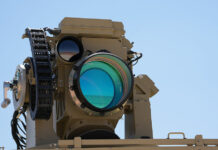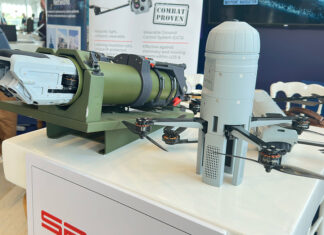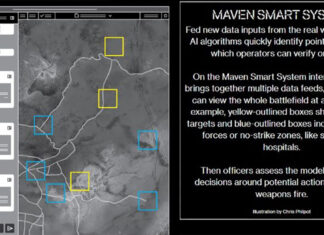
By using countermeasures against NAVWAR threats, Assured Positioning, Navigation, and Timing (APNT) is achieved. These countermeasures are as varied and sophisticated as the offensive capabilities they aim to neutralize. Nations and corporations worldwide have invested in technologies designed to detect, mitigate, and adapt to GNSS disruption and spoofing. Signal-behavior monitoring represents an important method of assessing the integrity of PNT systems at the system or unit level. By observing PNT signals for behavior such as dropouts, discontinuities, unusual signal fluctuations, data bit changes, or other anomalies, this technique can detect a potential failure or false manipulation of the source, indicate the system to revert to a ‘safe mode’, use of countermeasures, or act against the perpetrator.
A common combination provides navigation resilience using an inertial measurement unit (IMU) with a GNSS receiver. By correlating the GNSS position with the IMU data, the navigation system compares the position intervals reported by the GNSS subsystem with the relative position determined by directional accelerations and time measured by the IMU relative to the previous GNSS interval. Trusted timing standards are also part of such combined sensor systems, assessing the integrity of PNT signals. By correlating the information provided by the different sensors and an integral atomic clock, all the sensors must agree on the location and timing solution. If one sensor disagrees with the others, that sensor may be considered suspect, either for failure or compromise.
While this method is immune to external interference, it is susceptible to position measurement inaccuracies (also known as ‘drift’) proportional to the distance and time traveled. Adding Artificial Intelligence sensor fusion to the system enhances the system’s processing capabilities, primarily in an environment where satellite signals are obstructed or challenged, such as indoors or in urban areas. GPS/INS systems are common in most aviation and naval systems and are also being introduced in military land systems. However, due to the IMU cost and complexity, they are used mainly in high-value systems such as air defense, artillery, and recce units.
An anti-jam antenna unit is another method of PNT resilience. Anti-jam solutions use smart technologies such as controlled radiation pattern antennas to focus on satellite signals while attenuating the signal received from ground-based jammers.
A typical system of this class is the ADA GNSS Anti-Jamming system from IAI. ADA protects aircraft, drones, surface vehicles, or ships from GNSS disruption. It uses a multichannel antenna that filters out signals coming from undesirable directions. The technology can also detect and mitigate spoofing attacks, ensuring the integrity of GNSS signals. IAI offers ADA in several versions, including a lightweight system optimized for use on missiles, drones, and loitering weapons and the Compact ADA unveiled earlier this year.
Other systems developed by Elbit Systems’ Rokar unit are JaGuard and GUR. These systems use up to four antennae elements to perform null steering techniques and processing units to perform complex anti-jam and GNSS calculations simultaneously. The system is optimized for efficient multipath mitigation in urban or naval environments. JaGuard can be mounted on the platform, while GUR is designed for integration at the subsystem or embedded solution level.

The Canadian NovaTel is offering advanced anti-jamming antennas. These systems employ enhanced GNSS tracking performance, new direction-finding capabilities, improved electronic situational awareness, and a new silent mode feature that reduces its thermal signature. The system’s receiver employs algorithms that use various detection metrics at multiple stages within the signal processing to provide a robust overall spoofing detection alert. While the receiver may be spoofed, the resulting falsified position, navigation, and timing (PNT) measurements won’t fool the user. Because of the alert, users have increased situational awareness of when their receiver’s measurements may be untrustworthy.
While ADA, JaGuard, and GUR are designed specifically for the military user, other GNSS-AJ solutions have been optimized as dual-use systems. Infinidome, a pioneer in GNSS protection, has developed the GPS Dome, a cost-effective and compact system designed to shield commercial and military assets from jamming.
Infinidome, an Israeli GPS protection specialist company, has introduced GPSDome, which uses two antennae to perform passive ‘null steering’ by attenuating the reception from the direction of the most powerful signal (the jammer). The company developed a proprietary filter to isolate this signal and implemented it into an integrated circuit.

The latest generation, GPSDome2, is a software-defined GNSS-AJ solution that offers a wider frequency range, higher efficiency, and the ability to simultaneously deal with multiple jammers from three directions. GPSDome2 is packed in a small package weighing only 500 gr. That can be installed as a retrofit or in new systems. Under a collaboration with Honeywell, the system has been integrated into Honeywell’s Resilient Navigation System, introduced in 2022 as an aviation-certified navigation system designed to overcome GNSS vulnerabilities. A similar system is under development in South Korea in cooperation with Hanwha, which has also invested in the company. Both are positioned to provide these navigation capabilities for the Autonomous Air Mobility systems. (AAM).
Another method the US military uses to foil spoofing is the Selective Availability Anti-Spoofing Module (SAASM) GPS signal, employing encryption to discriminate between true and false signals. GPS satellites transmit signals with encrypted code, and SAASM-protected receivers have decryption keys that authenticate the signal. Military receivers deployed after 2006 were required to use SAASM. These techniques are not available to commercial users and require special authorization by the US Government. Therefore, not all military GNSS receivers use encrypted signals, and those that do not may be vulnerable to spoofing. The European Union (EU) Galileo system also supports encrypted signal techniques through the Public Regulated Service (PRS) reserved for EU government users.

View navigation, high jamming immunity,
fast direct acquisitions using either P(Y)
or M-Code and rapid cold starts with
no initialization data is required. Image: BAE Systems
While SAASM is available only to the US government and authorized users, other APNT applications employ software-based GNSS protection to detect spoofing attacks. The Pyramid system, developed by Regulus Cyber, detects, alerts, and reports the presence of GNSS spoofing signals, enabling the user to employ alternative navigation or correction measures to protect the navigation system and the platform. The system uses software updates to keep up with the latest attack methods.
Since 2018, when the first 3rd generation GPS satellite was deployed, a new encrypted M-Code has been used in the L1 and L2 GPS bands, supporting U.S. military operations. M-Code is designed to improve resistance to GPS threats such as jamming and spoofing. M-Code receivers use a higher-power signal to resist jamming interference and encryption, among other security features, to thwart spoofing attacks. M-Code support has been mandatory for all new military GPS receivers since 2017. Some forces of European Union members are also starting to get access to M-Code.



















